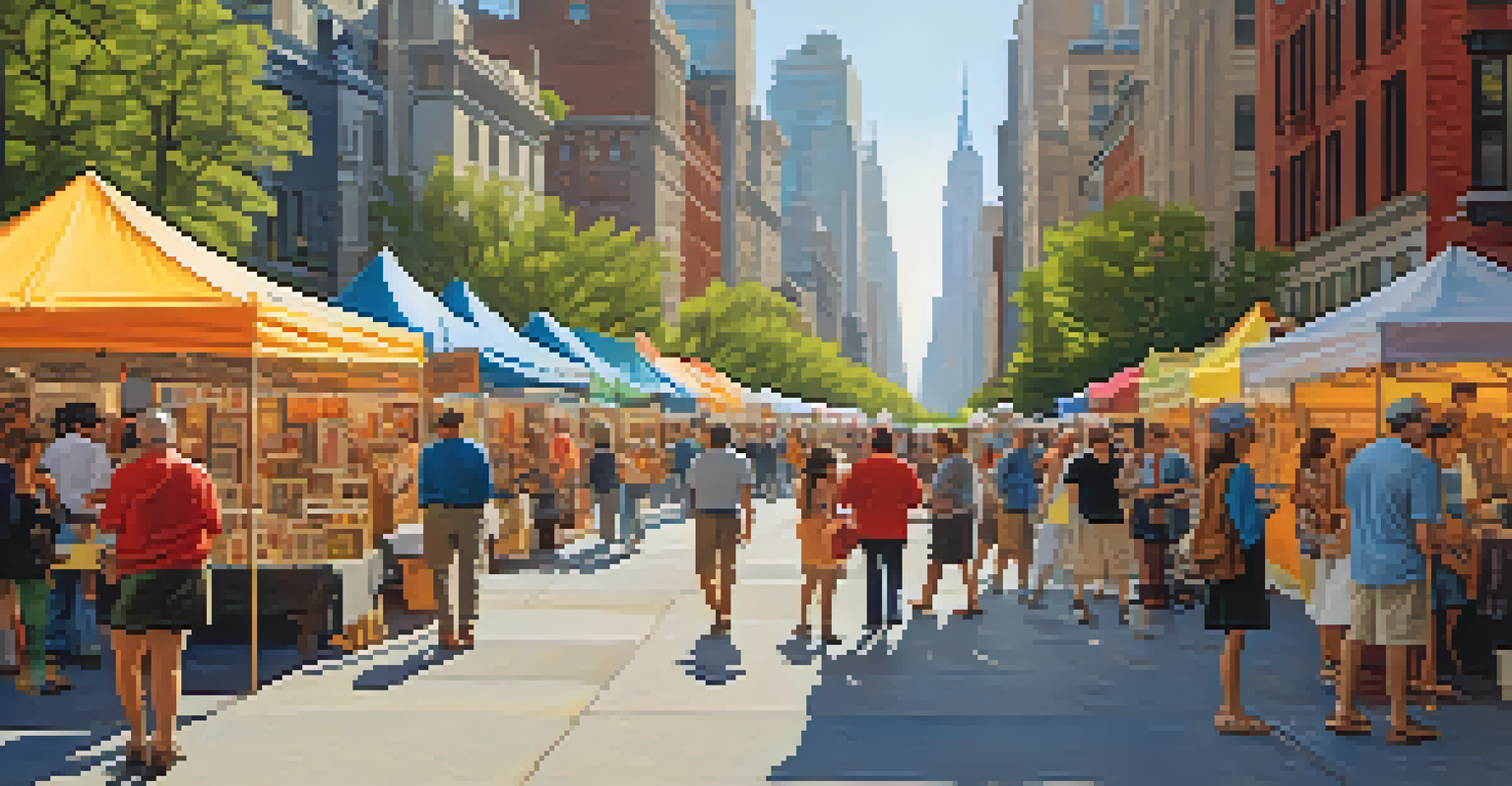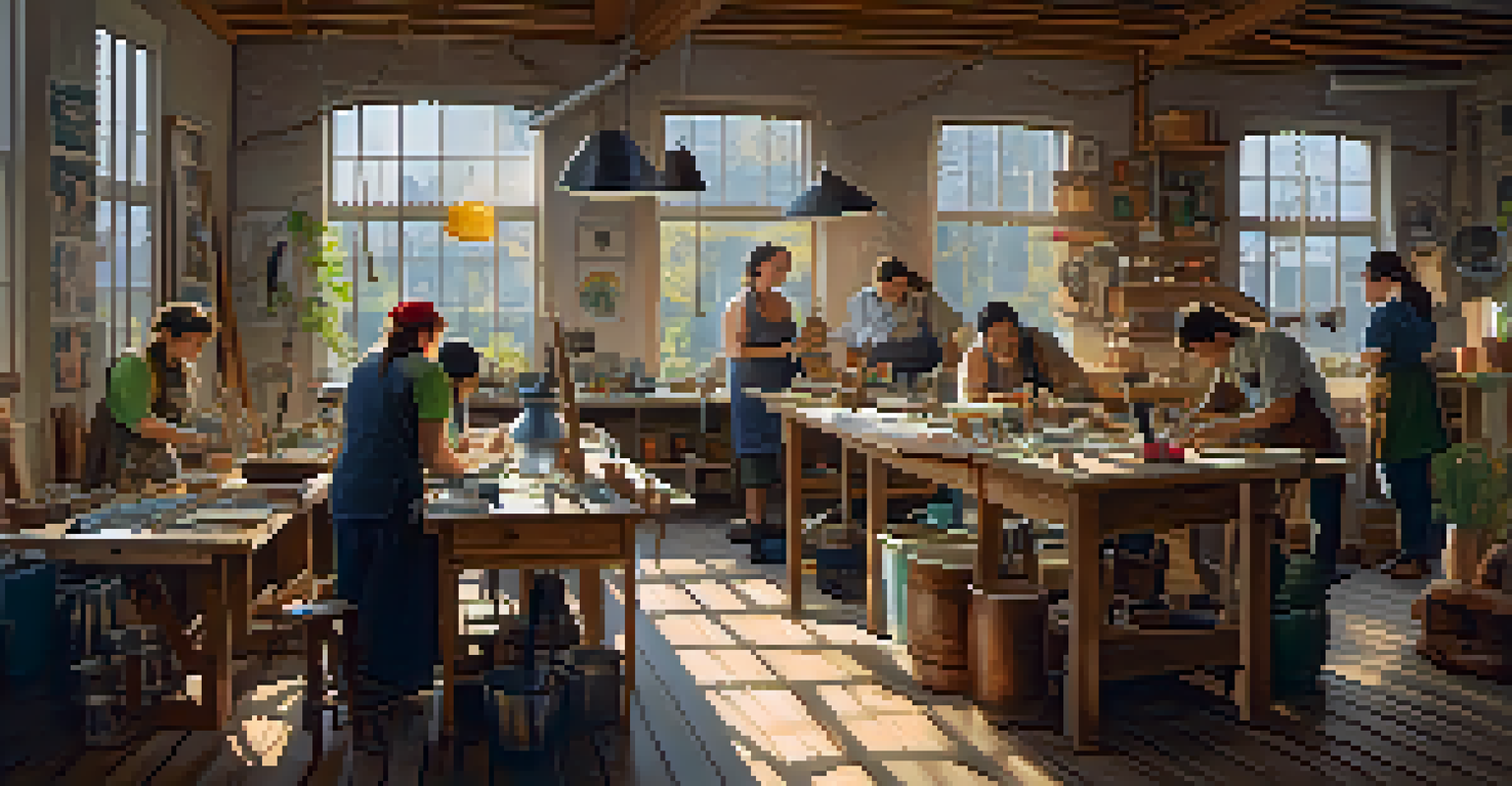Analyzing the Art and Craft Sector's Job Creation in NYC

The Importance of the Art and Craft Sector in NYC
New York City has long been a hub for creativity and innovation, making its art and craft sector vital to the city's economy. This vibrant sector not only showcases artistic talent but also plays a crucial role in job creation. Artists, crafters, and artisans contribute significantly to local employment, fostering a diverse array of job opportunities.
Art is the most beautiful of all lies.
From painters and sculptors to textile designers and craftspeople, the variety of professions within this sector is impressive. Many of these jobs support local businesses, galleries, and studios, creating a ripple effect that enhances community engagement. As people flock to NYC for its cultural offerings, the demand for skilled artisans only continues to grow.
Moreover, the art and craft sector helps to maintain the city's unique identity and charm. With its rich history of creativity, NYC attracts talent from around the globe, further solidifying its position as a leader in the arts. This not only provides jobs but also enriches the cultural fabric of the city, making it a more vibrant place to live and work.
Job Growth Trends in NYC's Art and Craft Sector
In recent years, the art and craft sector in NYC has experienced significant job growth, reflecting broader trends in the creative economy. Reports indicate that as the city continues to recover from economic downturns, the demand for creative services has surged. This growth is partly due to increased investments in art initiatives and support for local artisans.

For example, community art programs and galleries have emerged in various neighborhoods, providing platforms for artists to showcase their work. This not only creates jobs for those directly involved but also boosts employment in related fields such as marketing, administration, and event planning. The interconnected nature of these roles highlights the importance of collaboration within the sector.
Art and Craft Sector Drives Jobs
NYC's vibrant art and craft sector significantly contributes to job creation and local employment opportunities.
Additionally, technology plays a pivotal role in driving job growth in the art and craft sector. With the rise of online marketplaces, artisans are now able to reach global audiences, increasing sales and, consequently, the need for more hands-on deck. This trend demonstrates how innovation can create new avenues for employment within traditional fields.
Impact of Education and Training on Job Opportunities
Education and training are crucial elements that shape the landscape of the art and craft sector in NYC. Numerous institutions offer programs specifically designed to equip aspiring artists and crafters with the skills they need to succeed. These programs often include hands-on workshops, mentorship opportunities, and industry connections that can lead to job placements.
Creativity takes courage.
Moreover, community colleges and vocational schools have begun to emphasize practical training tailored to meet the demands of the local market. This ensures that graduates are not only talented but also well-prepared for the realities of the job market. As a result, a skilled workforce emerges, bolstering the creative economy.
In addition, continuing education programs provide existing professionals with the chance to refine their skills or explore new techniques. This commitment to lifelong learning fosters a culture of growth and adaptability, ensuring that the workforce remains competitive in an ever-evolving industry.
Challenges Facing Job Creation in the Art and Craft Sector
Despite the positive trends, the art and craft sector in NYC faces challenges that can hinder job creation. One major obstacle is the high cost of living in the city, which can make it difficult for emerging artists and crafters to sustain their practices. Many talented individuals are forced to seek employment outside their field, leading to a potential talent drain.
Additionally, competition within the sector is fierce. With so many creative individuals vying for attention, it can be challenging for newcomers to establish themselves and secure jobs. This competitive environment may discourage some aspiring artists from pursuing their passions, ultimately affecting the sector's growth.
Education Shapes Creative Workforce
Education and training programs are essential for equipping aspiring artists and crafters with the necessary skills to succeed.
Moreover, funding cuts to arts programs can further exacerbate these challenges. When public and private support diminishes, opportunities for artists to showcase their work or receive training often disappear. This can create a cycle that stifles innovation and job creation in the long run.
The Role of Local Government in Supporting Job Creation
Local government plays an essential role in supporting job creation within the art and craft sector in NYC. Through various initiatives and funding programs, city officials can help nurture the creative economy, ensuring that artists and crafters thrive. This support can take many forms, including grants, tax incentives, and access to affordable workspace.
Moreover, the government can foster partnerships between artists and local businesses, creating opportunities for collaboration and cross-promotion. Such partnerships not only enhance visibility for artists but also contribute to job creation within the community. When local businesses support the arts, they help cultivate a vibrant atmosphere that attracts visitors and residents alike.
Furthermore, policies aimed at preserving and promoting cultural spaces are crucial to the sector's growth. By investing in arts districts and cultural initiatives, local government can create a supportive environment for artists to flourish. This not only benefits individual creators but also strengthens the economy as a whole.
Community Engagement and Its Impact on Job Creation
Community engagement is a driving force behind job creation in NYC's art and craft sector. As local residents become more invested in their neighborhoods, they often seek out opportunities to support local artists and crafters. This can lead to increased demand for art-related services, ultimately creating more jobs within the sector.
Events such as art fairs, open studios, and workshops foster connections between artists and community members. These gatherings not only celebrate creativity but also provide a platform for artists to showcase their work and network with potential clients. The more engaged a community is, the more likely it is to support its local creatives.
Community Engagement Fuels Growth
Active community involvement enhances support for local artists, leading to increased demand and job creation in the sector.
Moreover, community-based art initiatives can have a transformative effect on neighborhoods. By bringing people together around a shared appreciation for art, these initiatives boost local economies and create a sense of belonging. As a result, job creation becomes a natural byproduct of a thriving artistic community.
Future Prospects for Job Creation in NYC's Art and Craft Sector
Looking ahead, the future of job creation in NYC's art and craft sector appears promising, driven by innovation and adaptability. As technology continues to evolve, artists and crafters will likely find new ways to connect with audiences and expand their reach. This could lead to the emergence of even more job opportunities within the sector.
Furthermore, as sustainability becomes a priority for consumers, there is a growing demand for eco-friendly art and craft products. This trend presents a unique opportunity for artisans to create jobs while promoting environmentally responsible practices. The intersection of artistry and sustainability will likely shape the future job market in this sector.

Finally, continued collaboration between artists, local businesses, and government entities will be essential for fostering a supportive ecosystem. By working together, stakeholders can ensure that NYC remains a vibrant center for creativity, innovation, and job creation in the art and craft sector for years to come.